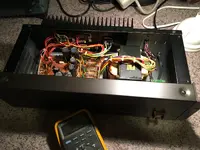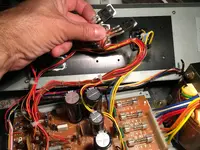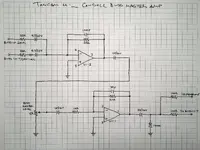I've spent many hours the last couple days on this...too much to be able to type right now, but I'm setting the power supply issues aside for now. The issue with AC in the +15VDC rail spontaneously went away...I've spent an hour looking over the PCB in excellent light with a jeweler's loupe and find no bad solder joints, fractures, etc...I can't get the problem to reappear so I'm letting it go for now because its working.
The mixer...
Good news: the stereo buss peak LEDs being stuck on issue is gone. I don't know where that problem came from, but with the mixer back in the frame its not happening.
Good news or at least relieving news, the master meters weren't working...they can source the stereo buss or the monitor buss, so I switched the source and they were working when sourced to the monitor buss...some quick thinking and I'd realized I installed a small buss PCB backwards...stereo buss meter activity back in business.
So I'm back to baseline which is sputtering crackly noise in the headphones, and a generally high noise floor.
Long story short I have determined it *isn't* just the headphones, its global to every output from the Control Module (the "master" module), and since the noise can by controlled by each buss' level control, the noise is upstream of the level each level control...it *has* to be coming from somewhere upstream of the Control Module...I re-do some tests I've done in the past as I'm now getting my head around maybe what's going on, and I verify the noise is NOT coming from the Control Module. So, good news, I can actually finally put the Control Module back together with all its cosmetic bits and call it "done".
So back to the noise...With the Control Module out of the frame and all the Input/output modules installed, I probe and monitor the motherboard connector terminals that bring the monitor, stereo, program and aux busses to the control module...there's the noise!!!
So it is coming from the motherboard itself or from the Input/Output modules. So I do some tests to see if it is one, or more, or all of the Input/Output modules generating the noise. I quickly deduce each Input/Output module is blasting out relatively high amplitude white noise from whatever program or aux buss slot it is plugged into...with them all plugged in they are blasting white noise across all program and aux busses, and I think the noise is bleeding across other busses and culminating in sputtering and crackling...I've got a global issue here.
My gut is the noise is not actually being generated within each Input/Output module, but rather there is some problem with the motherboard that manifests when a module is plugged in.
Here is a YouTube video I captured to memorialize the problem and convey to evm1024...it was late...my brain was dragging a bit, so I'm not sure how much sense it will make to viewers, but here it is nonetheless:
https://youtu.be/Bq5yeAaFqBw
I'm suspicious of my grounding mods I did in 2014. Its a bit whacky on this console...normally you want to isolate audio power rail grounds in the power supply, from each other, and then bond them together with the mixer frame as close as possible to the entry point of the umbilical to the frame...then make sure all metal elements of the mixer frame are bonded together. Then any point of the mixer frame becomes a low impedance shunt access point for any audio ground connection coming into or going out of the mixer...and the power supply chassis gets bonded to the mixer frame through the power umbilical. In this way noise is shunted as close as possible to ingress/egress points, AND you avoid ground loops. And then any NON-audio power rail grounds stay isolated from the audio ground plane. Well...here's the wrinkle...on the M-__ there is a +6VDC power rail that powers the meter lamps and all the LED indicators...
but it also powers the headphone amp. I think....I think I bonded that power rail's ground with all the other audio rail grounds in the mixer simply because it powers audio circuitry (the headphone amp)...If I'm recalling correctly, I think that was a mistake...I'll need to check. I don't know if that is causing this problem, but I have a hunch it is causing *some* problem(s) because I think there are separate signal ground paths for the headphone circuit, and I think I might be creating a global ground-loop issue...not sure...need to test and experiment.



 progress is being made. Funny how that tiny cap was causing so many problems.
progress is being made. Funny how that tiny cap was causing so many problems.









